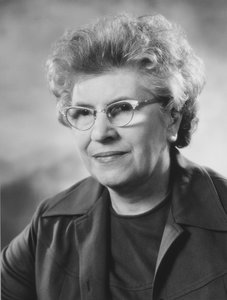Sylvia Agnes Sophia Tait facts for kids
Quick facts for kids
Sylvia Agnes Sophia Tait
|
|
|---|---|
 |
|
| Born |
Sylvia Wardropper
8 January 1917 Tyumen, Siberia
|
| Died | 28 February 2003 (aged 86) Lymington, Hampshire
|
| Alma mater | King's College, London University College London |
| Spouse(s) | Anthony Simpson (1940–41) James Francis Tait (m. 1956) |
| Scientific career | |
| Fields | Endocrinology |
| Institutions | Courtauld Institute of Biochemistry |
Sylvia Agnes Sophia Tait (born January 8, 1917 – died February 28, 2003) was a British scientist. She was a biochemist, studying the chemistry of living things. She was also an endocrinologist, focusing on hormones.
Sylvia Tait worked closely with her second husband, James Francis Tait. They worked together from 1948 until her death in 2003. Their teamwork is seen as one of the most successful husband-and-wife science partnerships ever.
Together, they made a big discovery. They found and identified a hormone called aldosterone. This hormone helps control your blood pressure. It helps your body keep sodium, get rid of potassium, and hold onto water. This can raise blood pressure. Aldosterone is thought to be involved in about 15% of cases of high blood pressure.
Contents
Early Life and Education
Sylvia Tait was born in 1917 in Tyumen, a city in Siberia. Her father, James Wardropper, was from Scotland and worked as a farmer and trader. Her mother, Ludmilla, was Russian and had a math degree from the University of Moscow.
In 1920, Sylvia and her family moved back to the UK. They lived in Ealing, where her father became a civil engineer. Sylvia went to Ealing County School for Girls. She was very good at languages. She spoke Russian fluently and improved her German by visiting relatives in Germany.
Sylvia first studied languages at King's College, London. Later, she switched to University College London. She earned a degree in zoology, the study of animals, in 1939. In 1940, she married Anthony Simpson, who was also a zoology student. He was a pilot in the Royal Air Force and sadly died in Norway in 1941.
Scientific Discoveries
After her first husband passed away, Sylvia began using her married name, Simpson. Around 1941, she joined a research team in Oxford. There, she studied how nerves grow back after being damaged.
In 1944, she moved to the Courtauld Institute of Biochemistry in London. She worked on creating new pain medicines to replace opiates. She also studied oestrogens, which are female hormones. This work helped her become an expert in bioassays. Bioassays are tests that use living things to measure how strong a substance is.
Discovering Aldosterone
In 1948, Sylvia started working with James Francis Tait. They focused on hormones from the adrenal glands. They created new ways to find these hormones using special paper tests and ultraviolet light.
They were part of a team that found a new active compound. They called it electrocortin. Soon, they realized it was a new hormone made by the adrenal gland. This hormone was later named aldosterone.
Their team included a famous Swiss chemist, Tadeus Reichstein. He had won a Nobel Prize for similar work on another hormone called cortisol. The discovery of aldosterone was announced in the science magazine Nature in 1952.
A Scientific Partnership
Sylvia married James Tait in September 1956. She then started using her new last name, Tait, for her work. This sometimes caused a little confusion!
In 1959, both Sylvia and James Tait became Fellows of the Royal Society. This is a very high honor for scientists in the UK. They were the first married couple to be chosen as Fellows on the same day.
The Taits continued their research together. They moved to the Worcester Foundation for Experimental Biology in Massachusetts, USA. There, they studied cells from the adrenal gland. They also spent time doing research in Australia. In 1970, they returned to London. James Tait became a professor, and they both directed a special unit for studying hormones.
Later Years and Legacy
The Taits retired in 1982 and moved to the New Forest area in England. Even in retirement, they kept doing scientific research. They used two early computers, Apple IIes, to run simulations.
Sylvia Tait had health problems in her later years. She passed away in 2003 from kidney and heart failure. She died just before a meeting in London that celebrated 50 years since the discovery of aldosterone.
At the time of her death, Sylvia Tait was the oldest living woman who was a Fellow of the Royal Society in Britain. She was also a member of several important science groups in both Britain and America. Her work with James Tait greatly advanced our understanding of hormones and how they affect the human body.

